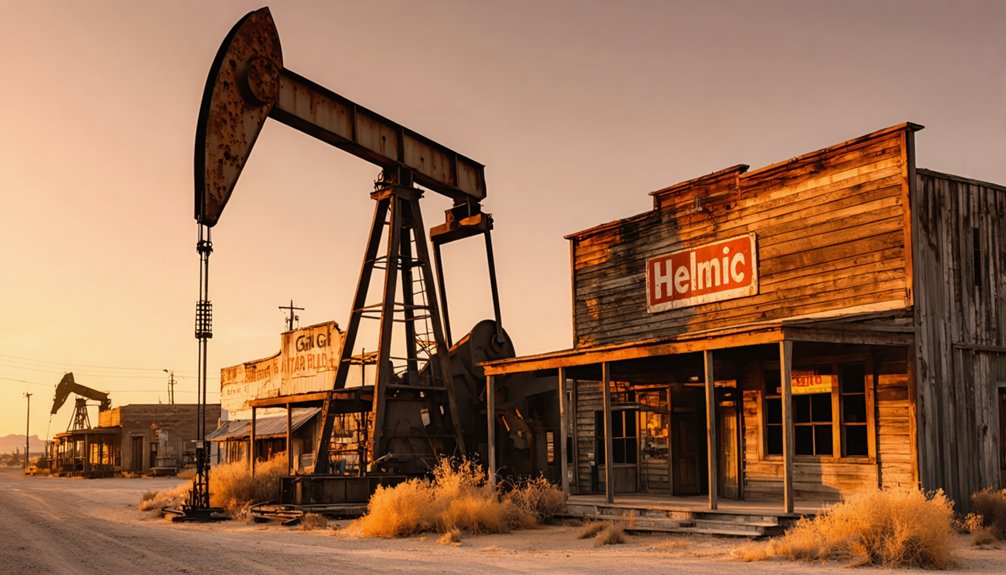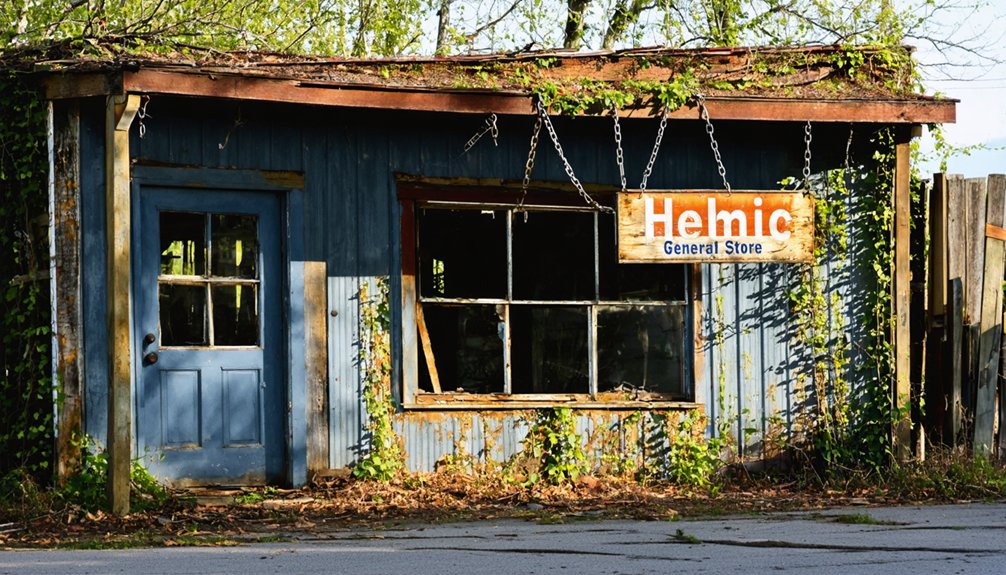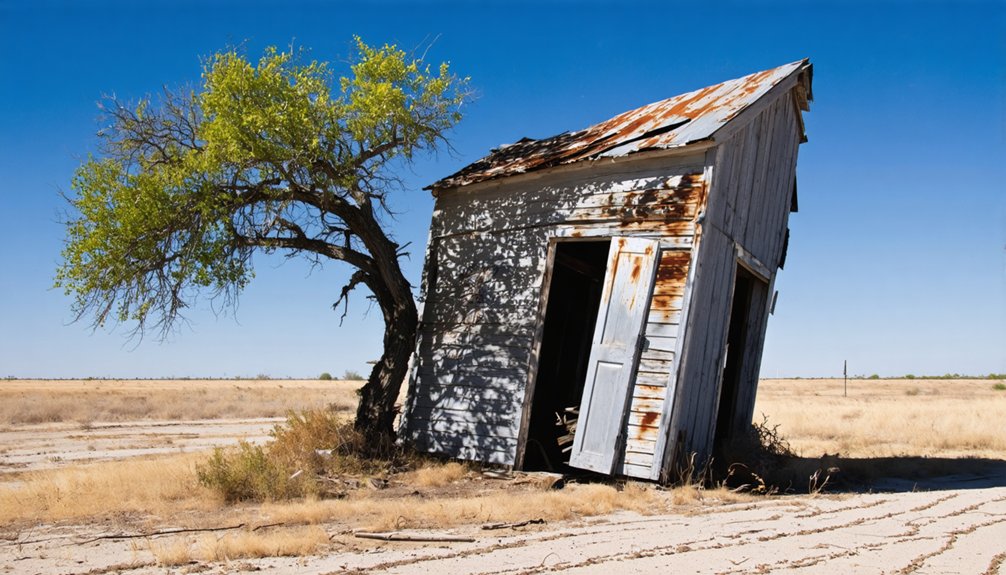You’ll find Helmic’s beginnings in 1908 as Alabama Station along the Groveton, Lufkin and Northern Railway. By 1910, it was renamed Helmic after a railway surveyor, and in 1914, Trinity County Lumber Company transformed this small stop into a bustling timber town. The population grew from 50 to 300 during the lumber boom, but when operations moved to Colmesneil and timber supplies dwindled, Helmic’s liveliness faded. The abandoned site holds countless stories of East Texas’s timber era.
Key Takeaways
- Helmic, Texas began as a railroad station in 1908 and was renamed in 1910 after a railway surveyor.
- The town flourished during the lumber boom, growing from 50 to 300 residents after Trinity County Lumber Company arrived in 1914.
- Helmic’s decline began when lumber operations relocated to Colmesneil and timber resources became depleted in the early 20th century.
- Workers lived in modest wooden homes near the town center, with daily life revolving around lumber camp operations.
- The town’s isolation deepened when highway improvements bypassed it, leading to its eventual abandonment as a ghost town.
The Rise of a Lumber Town
In the heart of East Texas’s pine country, Helmic emerged in 1908 as a modest railway stop called Alabama Station along the Groveton, Lufkin and Northern Railway.
Two years later, the settlement adopted its new name, Helmic, honoring a railway surveyor who’d overseen local construction.
A humble rail stop found its identity in 1910, christened after the surveyor who helped shape its rails.
The town’s destiny changed dramatically in 1914 when the Trinity County Lumber Company established operations there. Like many lumber operations of the era, workers were often paid in merchandise checks that could only be spent at company-owned stores.
When lumber operations moved to Colmesneil, the town’s prosperity began to fade.
As lumber harvesting intensified, Helmic transformed from a simple rail stop into a bustling community.
The town’s population surged from 50 to nearly 300 residents as timber processing operations expanded.
You’d have found a thriving community complete with two grocery stores and three general stores, all serving the hardworking lumber families who’d made Helmic their home amid the towering virgin pines of East Texas.
Life in Early Helmic
You’d find the daily routines in early Helmic dominated by the rhythms of lumber camp life, where workers rose before dawn to begin their shifts at nearby sawmills and logging sites.
The town’s small railroad station bustled with activity as timber loads were prepared for transport, while workers’ families tended to household duties and small garden plots that supplemented their meals. Workers were forced to use company scrip at the local store for their purchases, limiting their economic freedom. Like many communities that relied on railroads, Helmic’s fate was sealed when railroad rerouting led to its eventual decline.
Community gatherings often centered around the railway depot on paydays, when residents would congregate to share news, trade goods, and occasionally enjoy impromptu music sessions after the day’s work was done.
Daily Lumber Camp Routines
Life at Helmic’s lumber camps revolved around a demanding sunrise-to-sunset schedule, where workers endured shifts often exceeding 10 hours.
You’d start your day inspecting equipment and preparing horses for hauling, while logging crews headed into the forest with their crosscut saws and axes. Worker safety depended heavily on experienced personnel supervising logging techniques in the hazardous conditions.
You’d break for hearty meals in the communal mess hall, dining on beans, salted meat, and biscuits to fuel the intense physical labor. A woods boss maintained strict authority over the 40-60 men working in each timber crew.
Between meals, you’d find yourself either felling trees, operating skidders to drag logs, or processing lumber at the mill. The mill’s impressive capacity meant workers could process up to 75,000 board feet of lumber each day.
When dusk approached, you’d return to simple bunkhouses or tents, resting briefly before another grueling day began.
Community Social Activities
Beyond the exhausting lumber camp routines, social activities breathed life into early Helmic’s close-knit community. You’d find townsfolk gathering in multipurpose buildings and open fields, sharing stories around campfires, and celebrating life’s milestones. Cultural influences from European immigrants enriched these community gatherings, bringing diverse traditions, foods, and music to local festivities. Today, residents can explore these social gathering spots using historical topographic maps that reveal forgotten community spaces. Much like the pioneers who settled Indianola before it submerged beneath Matagorda Bay, the residents of Helmic created lasting memories through their social bonds.
- Church-sponsored events and Sunday services united residents while reinforcing moral values.
- Seasonal festivals incorporated ethnic customs, fostering cultural exchange among neighbors.
- Baseball games and foot races provided entertainment and friendly competition.
- Schoolhouses doubled as social hubs for literacy groups and community meetings.
Whether you were fishing in the piney woods, attending a barn dance, or joining a quilting circle, you’d experience the strong social bonds that defined early Helmic’s vibrant community spirit.
Railroad Station Operations
While many Texas towns sprouted from agricultural roots, Helmic’s story began as a strategic stop on the Groveton, Lufkin and Northern Railway in 1908. Originally called Alabama Station, it was renamed Helmic in 1910 and quickly became a crucial hub for the region’s bustling lumber industry. Like the Texas and New Orleans Railroad, the station played a vital role in connecting communities across the state.
You’d find the station humming with activity during its heyday, coordinating freight logistics for lumber shipments and managing passenger services. The mechanical interlocker system, similar to those used at other Texas railroad junctions of the era, helped control train movements through the station. Railroad communication systems kept Helmic connected to other stops along the line, while the station’s infrastructure supported both passenger platforms and freight loading areas.
When the Trinity County Lumber Company set up camp in 1914, the station’s significance grew exponentially. By the 1920s, you could count around 300 residents in Helmic, all benefiting from the railroad’s economic lifeline.
Railroad’s Influence and Development
As a stop on the Groveton, Lufkin and Northern Railway, Helmic emerged in 1908, marking its place in Trinity County’s transportation network.
Railroad expansion transformed this former Alabama Station into a bustling hub of commerce and settlement. You’ll find the railway’s influence reflected in the town’s rapid growth, as the population surged from 50 to 300 residents during the 1910s-1920s.
- Trinity County Lumber Company established operations in 1914, drawn by the railway’s strategic location.
- The railroad facilitated lumber transport and goods delivery, creating a thriving local economy.
- Stores and postal services clustered around the railway stop, forming a commercial center.
- The town’s integration into regional transportation networks sparked economic opportunities until the lumber company’s departure.
The railroad’s presence defined Helmic’s rise and eventual decline, shaping its destiny in East Texas’s evolving landscape.
Economic Foundations and Industry

The coal mining industry shaped Helmic’s economic landscape long before the railroad’s arrival. You’d find the Texas and Pacific Coal Company controlling every aspect of life, with founders Robert Dickey Hunter and H.K. Thurber establishing tight economic dependency through company stores and scrip payments instead of cash.
If you’d worked in Helmic’s mines, you’d have faced grueling labor struggles, receiving only monthly paychecks while being forced to shop at the company’s commissary.
The town’s perimeter, wrapped in barbed wire and patrolled by armed guards, kept union organizers out and workers in. Immigrant miners, many unable to speak English, found themselves particularly vulnerable to exploitation.
This rigid company control ultimately contributed to Helmic’s downfall when mining operations declined, leaving workers with no alternative employment options.
Community and Daily Living
You’d find the residents of Helmic living in modest wooden homes clustered near the town’s center, where they formed tight-knit social bonds through church gatherings and community events.
Your typical day in this rural Texas settlement would’ve revolved around agricultural work and domestic duties, with families sharing labor and resources to support one another.
When you weren’t tending to daily chores, entertainment came through social activities like church meetings, local markets, and informal gatherings among neighbors.
Lumber Camp Living Conditions
Life in Helmic’s lumber camps revolved around stark, utilitarian conditions that prioritized work efficiency over comfort.
You’d find yourself living in temporary housing structures like boxcars or tents, especially if you worked at the remote logging sites. Basic hygiene facilities existed in some camps, but lumber camp hygiene remained a constant challenge due to muddy conditions and limited amenities.
- Your shelter would’ve lacked proper insulation against East Texas’s harsh weather.
- You’d start work at dawn and continue until dusk, with minimal breaks.
- You’d rely on lanterns or oil lamps, as electricity wasn’t available.
- Your meals would consist mainly of preserved meats, beans, and bread.
The isolated nature of these camps meant you’d spend most of your time focused on work, with few comforts or recreational options available.
Social Ties and Families
Despite harsh working conditions in the lumber camps, strong social bonds formed the backbone of Helmic’s community life. You’d find multi-generational families living close together, pooling their labor for the lumber industry while supporting each other through extensive kin networks.
Your children would have been watched by grandparents or aunts while you worked, and your neighbors would’ve been just as likely to be your relatives through marriage.
The local church served as your primary gathering spot, where you’d join others for worship, celebrations, and community meetings.
During work breaks or market days, you’d exchange news and stories with fellow townspeople.
When crises struck – whether illness, fire, or economic hardship – you could count on your neighbors rallying to help, demonstrating the tight-knit family dynamics that defined Helmic’s social fabric.
Entertainment and Recreation
Recreation in Helmic centered around simple pleasures and community bonds during the lumber camp era of the early 1900s.
You’d find locals gathering at the general stores for card games and conversation, while outdoor recreational activities like fishing and hunting in the piney woods provided entertainment year-round.
The railroad’s presence until the 1930s allowed residents to venture to nearby towns for social gatherings and regional events.
- Community picnics and dances at the lumber camp brought workers and families together
- School events featured seasonal celebrations, plays, and children’s sports
- General stores served as social hubs for games and storytelling
- Traditional pastimes included fishing, hunting, and hiking in surrounding woodlands
The removal of railroad tracks and declining population eventually led to fewer organized entertainment options, though the school continued hosting community events into the 1940s.
The Path to Abandonment
When timber supplies began dwindling in the piney woods of Trinity County during the early to mid-20th century, Helmic’s fate was sealed.
You’d have witnessed the town’s economic vulnerabilities exposed as logging operations shut down one by one, leaving workers with few options but to seek employment elsewhere. The railroad stop that once bustled with timber shipments grew quiet, and population dynamics shifted dramatically as younger residents fled.
As timber mills fell silent one by one, workers departed, leaving only whispers of prosperity at the abandoned railroad stop.
The town’s isolation deepened when highway improvements bypassed Helmic completely. Without its timber industry or transportation advantages, you’d have seen businesses close, schools shutter, and families move away.
The remaining structures surrendered to the elements, leaving only a namesake road and scattered ruins as evidence to the once-thriving logging community.
Legacy in Trinity County

Although Helmic’s physical presence has faded into Trinity County’s landscape, its legacy endures as a tribute to East Texas’s timber boom era.
When you explore Trinity County’s history, you’ll find Helmic’s story woven into the economic shifts that shaped the region’s development. The small community’s rise and fall mirrors the broader pattern of resource-dependent settlements that once dotted East Texas, leaving cultural remnants that still influence the area’s identity.
- Trinity County Lumber Company established Helmic in 1914, marking the beginning of intensive timber operations.
- The town’s population of 50 residents represented the mobile workforce that characterized early 20th-century lumber camps.
- Helmic contributed to Trinity County’s economic framework alongside hunting and fur trading activities.
- The ghost town’s preservation in historical records helps document East Texas’s transformation from timber dependency.
Frequently Asked Questions
Are There Any Remaining Structures or Buildings From Helmic’s Lumber Town Era?
You won’t find any remaining buildings from the lumber town era in Helmic today – all structures of historical significance disappeared after Trinity County Lumber Company left and the post office closed in 1933.
What Happened to the Families Who Lived in Helmic After Abandonment?
Over 85% of the families spread across East Texas, with many settling in Trinity and Groveton. You’ll find their descendants followed economic opportunities, taking up farming, ranching, and railroad work instead of mining.
Did Helmic Have Its Own School System During Peak Operations?
While you’ll find limited records on Helmic’s school history, it’s likely children received basic education through a one-room schoolhouse rather than an independent system during the town’s early 1900s timber operations.
Were There Any Significant Natural Disasters That Contributed to Helmic’s Decline?
Clear as crystal, you won’t find natural disasters in Helmic’s story. The town’s decline came purely from the lumber company’s departure and railroad removal, not from Mother Nature’s fury.
What Native American Tribes Originally Inhabited the Area Before Helmic’s Establishment?
You’ll find the Akokisa tribe primarily inhabited the Trinity River area, while Karankawa and Atakapa peoples also shared cultural significance in this coastal region before European settlement shaped tribal history.
References
- https://www.youtube.com/watch?v=phjUE19A8HM
- https://kids.kiddle.co/Helmic
- https://tpwmagazine.com/archive/2018/jan/wanderlist_ghosttowns/
- https://en.wikipedia.org/wiki/List_of_ghost_towns_in_Texas
- https://texashighways.com/culture/history/what-the-heck-is-a-ghost-town/
- https://www.ghosttowns.com/states/tx/helmic.html
- https://www.tshaonline.org/handbook/entries/helmic-tx
- https://www.texasescapes.com/CentralTexasTownsSouth/Hermis-Texas.htm
- https://www.tshaonline.org/handbook/entries/lumber-industry
- https://scholarworks.sfasu.edu/cgi/viewcontent.cgi?article=2759&context=ethj



